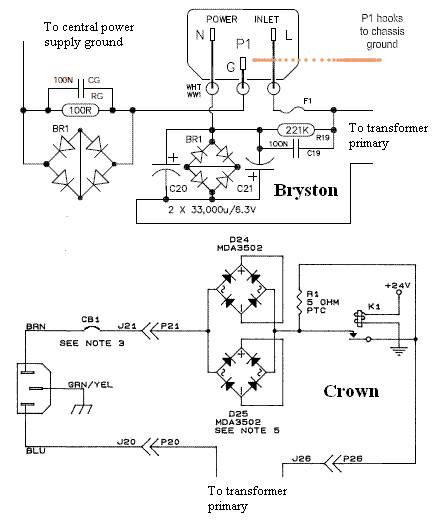Never really took it seriously. The plugs in my home are grounded. But I have some vintage amps in the mix with little two prong plugs and thought I'd get serious about grounding everything. No big problem with him at this time.
I decided to run a 16ga stranded wire out to the nearest clearly verifiable connection to the service box ground that is wired to a copper rod in the ground. I ran the wire to the back of my ol' reliable Hitachi HA-330. Then I daisy chained that to my six disk yamaha changer and my HP laptop used for internet web radio.
The hum increased 100 percent! I removed the ground to the amp. 80 percent of the added hum stopped. Removed the daisy chain to the laptop. 15 percent stopped. I remove the jumper between the amp and the cd player. 4 more percent stopped. (there's always a tiny bit of hum there as ambience I guess)
So what gives? What is the proper method to have all components in a system commonly grounded?
I decided to run a 16ga stranded wire out to the nearest clearly verifiable connection to the service box ground that is wired to a copper rod in the ground. I ran the wire to the back of my ol' reliable Hitachi HA-330. Then I daisy chained that to my six disk yamaha changer and my HP laptop used for internet web radio.
The hum increased 100 percent! I removed the ground to the amp. 80 percent of the added hum stopped. Removed the daisy chain to the laptop. 15 percent stopped. I remove the jumper between the amp and the cd player. 4 more percent stopped. (there's always a tiny bit of hum there as ambience I guess)
So what gives? What is the proper method to have all components in a system commonly grounded?
Hi,
The problem some of the old vintage amplifiers the audio signal it is connected to the chassis. One example it is the Dynaco 120. The speaker and the audio input signal it is grounding to the chassis. If you want to ground it to the earth ground you need to float everything that had to do with the audio signal. In other word try to wire it as a star ground.
The problem some of the old vintage amplifiers the audio signal it is connected to the chassis. One example it is the Dynaco 120. The speaker and the audio input signal it is grounding to the chassis. If you want to ground it to the earth ground you need to float everything that had to do with the audio signal. In other word try to wire it as a star ground.
A groundloop was probably introduced as a result of connection to ground.
Be aware that commercially manufactured equipment with two prong plugs have been constructed in such a way that connection to protective earth (PE), also known as safety earth, is not required. These are so-called double insulated and should carry the square-in-square symbol, (usually) on the rear panel.
The advice given by tauro0221 to float signal reference (GND) with respect to PE is not one I would recommend. GND must be connected to the casing to get proper shielding. In other words, devices that are constructed to have PE connected to the casing will also have GND connected to it in a strategic position. The interconnection between PE and GND is what can introduce a groundloop. For safety reasons, PE must never be disconnected from the case. That leaves floating GND with respect to the case, possibly with less shielding as penalty.
With a logical approach, you can have PE and GND connected to a case and have no groundloops.
A good article explaining grounding and what can go wrong can be found here.
Be aware that commercially manufactured equipment with two prong plugs have been constructed in such a way that connection to protective earth (PE), also known as safety earth, is not required. These are so-called double insulated and should carry the square-in-square symbol, (usually) on the rear panel.
The advice given by tauro0221 to float signal reference (GND) with respect to PE is not one I would recommend. GND must be connected to the casing to get proper shielding. In other words, devices that are constructed to have PE connected to the casing will also have GND connected to it in a strategic position. The interconnection between PE and GND is what can introduce a groundloop. For safety reasons, PE must never be disconnected from the case. That leaves floating GND with respect to the case, possibly with less shielding as penalty.
With a logical approach, you can have PE and GND connected to a case and have no groundloops.
A good article explaining grounding and what can go wrong can be found here.
Last edited:
Hum-X
http://www.sweetwater.com/images/items/1800/HumX-xlarge.jpg
This is what's inside:

The left bridge in the Bryston schematic detail (the right bridge is a DC blocker).
The Hum-X uses a pair of 6A diodes in inverse parallel. Each chassis ground must be run through a diode pair for isolation.
If you still have some hum at that point then you need a transformer on the signal cables, usually between the amp and preamp, maybe between the computer and the preamp.
http://www.google.com/patents?id=nBufAAAAEBAJ&printsec=abstract#v=onepage&q&f=false
http://www.sweetwater.com/images/items/1800/HumX-xlarge.jpg
This is what's inside:

The left bridge in the Bryston schematic detail (the right bridge is a DC blocker).
The Hum-X uses a pair of 6A diodes in inverse parallel. Each chassis ground must be run through a diode pair for isolation.
If you still have some hum at that point then you need a transformer on the signal cables, usually between the amp and preamp, maybe between the computer and the preamp.
http://www.google.com/patents?id=nBufAAAAEBAJ&printsec=abstract#v=onepage&q&f=false
Last edited:
- Status
- This old topic is closed. If you want to reopen this topic, contact a moderator using the "Report Post" button.